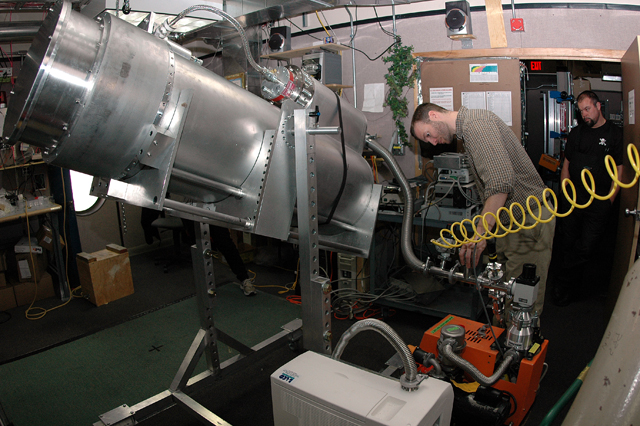|
Page 2/3 - Posted April 1, 2011
Getting into the actThe South Pole Station sits on the high, dry and cold polar plateau — characteristics appealing for CMB experiments that require a very stable atmosphere for the measurements physicists need to make. The first effort to measure the anisotropy of the CMB from the South Pole came in the mid-1980s. By 1991, the National Science Foundation CARA’s first CMB telescope, Python, debuted at Pole in late 1992, and it detected CMB anisotropy only a few months after the COBE results. In 1994, it became the first CMB telescope to operate during a South Pole winter. Kovac was fresh out of undergraduate school when he wintered over to work on the Python telescope. The experiment proved it was possible to operate during a South Pole winter, though there were many lessons learned from that first season, according to Kovac. “It was very exciting time. I was glad to get in as a student, to ride a wave in a field that was really in the process of exploding,” he said. The next generation of telescopes marched through: VIPER and ACBAR, DASI and QUAD. The Degree Angular Scale Interferometer Now Kovac and his colleagues are searching the CMB once again for inflation, a discovery that would be on par with the COBE results, which earned the 2006 Nobel Prize in Physics. 
Photo Credit: Peter Rejcek
The BICEP2 telescope with the MAPO building that holds the SPUD telescope in the distance.
“It’s an amazing theory, and it’s so far removed from the energy scales and realms that we can normally test that it is quite impressive to me that we can work it in enough detail to design a machine that says whether or not it’s true,” Kovac said. Making wavesJustus Brevik is sipping on perhaps the strongest, darkest cup of coffee at the South Pole. The 24-hour horizontal rotation of the sun makes day and night meaningless during the summer, and the PhD student from the California Institute of Technology has worked tirelessly on troubleshooting some software glitches on the BICEP telescope. The dark blue pedestal of the telescope dominates this half of the Dark Sector Lab, which also houses the much larger South Pole Telescope (SPT) Brevik explained that the width of the beam from the telescope is inverse to the size of the telescope’s aperture. “We’re very small on the ground, but we actually have very big beams on the sky,” he said. Those beams are trained on the CMB, through a spot in the Southern Hemisphere called the Southern Hole, a “clean” patch in the night sky that has low emissions of polarized dust that could hamper measurements. CMB telescopes like BICEP can’t directly revisit the moment of inflation. The cosmic microwave background is opaque, meaning the youngest snapshot physicist have of the early universe is at 380,000 years old. “In order to see beyond that screen, we need to probe other things. We have to probe the pattern on the cosmic microwave background,” Brevik said. “If you rapidly expand the fabric of space-time, you’re going to generate gravity waves.” Those gravity waves, referred to as B-mode, leave a distinctive signal on the surface of the CMB when they interact with the plasma. B-mode polarization has a spiral quality called curl, which would look like hurricanes in a hypothetical map of the polarization of the CMB. “It’s a geometric pattern that can be distinguished from maps of extreme sensitivity,” explained Kovac, who is also a principal investigator on the BICEP experiment.Back 1 2 3 Next |



For USAP Participants |
For The Public |
For Researchers and EducatorsContact UsU.S. National Science FoundationOffice of Polar Programs Geosciences Directorate 2415 Eisenhower Avenue, Suite W7100 Alexandria, VA 22314 Sign up for the NSF Office of Polar Programs newsletter and events. Feedback Form |


